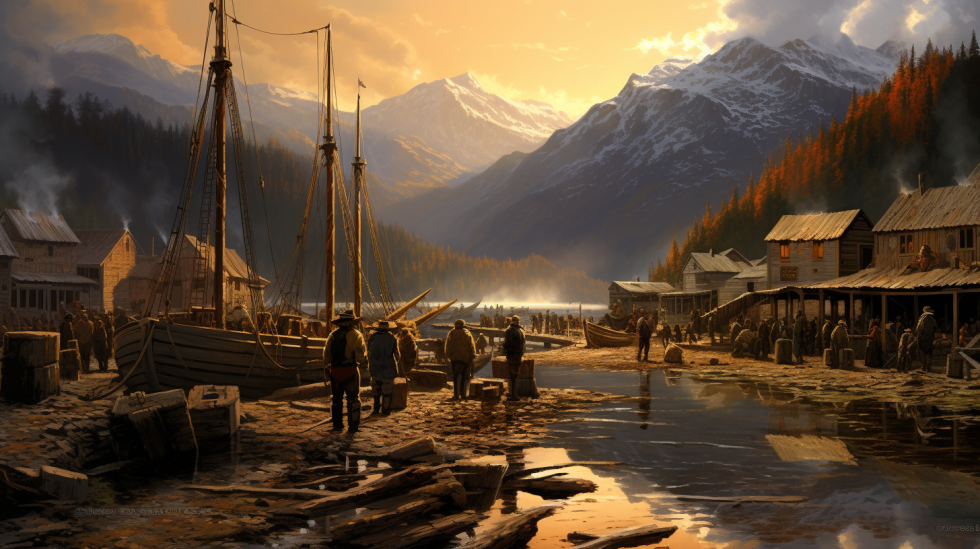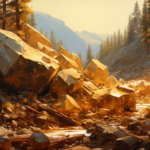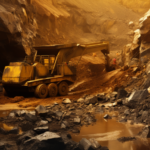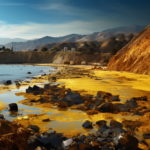In the closing years of the 19th century, a glittering discovery in the remote wilderness of Canada’s Yukon Territory set off a stampede of prospectors, adventurers, and dreamers. The Klondike Gold Rush, often called the “Last Great Gold Rush,” was a remarkable chapter in the history of North America, characterized by freezing temperatures, rugged terrain, and the pursuit of riches. In this exploration of “The Klondike Gold Rush,” we delve into the origins, hardships, and lasting legacy of this frigid frenzy in the North.

The Spark of Discovery
The Klondike Gold Rush was ignited by the discovery of gold along the Klondike River, a tributary of the Yukon River in the Canadian Yukon Territory. The first significant find occurred in August 1896 when George Carmack, Skookum Jim, and Dawson Charlie discovered gold in Bonanza Creek, a tributary of the Klondike River.
1. The Discovery Party: George Carmack, Skookum Jim, and Dawson Charlie were among the many prospectors who had journeyed to the Yukon in search of gold. Their find would soon trigger an unprecedented rush to the Klondike.
2. The Bonanza Creek Strike: The discovery of gold in Bonanza Creek set off a wave of excitement among prospectors already in the area. News of the strike soon reached other mining camps and settlements.
The Great Migration North
The Klondike Gold Rush attracted a diverse array of fortune seekers from all over the world, each drawn by the prospect of striking it rich. This mass migration transformed the Yukon and had a lasting impact on the region.
1. “Stampeders”: The prospectors who embarked on the journey to the Klondike were often called “Stampeders” because they rushed to the region with great haste. They came from diverse backgrounds, including miners, laborers, businessmen, and adventurers.
2. Chilkoot and White Passes: To reach the Klondike, Stampeders had to traverse treacherous mountain passes, including the Chilkoot and White Passes. They carried heavy loads of supplies and equipment, a task that often required multiple trips.
3. Dawson City: Dawson City, located near the confluence of the Klondike and Yukon Rivers, became the epicenter of the Gold Rush. It grew rapidly into a bustling town with saloons, stores, and businesses catering to the needs of Stampeders.
The Hardships of Klondike Mining
Mining in the Klondike was an incredibly challenging endeavor. The harsh climate, difficult terrain, and scarcity of resources made it a test of endurance for those seeking their fortunes.
1. Working the Claims: Miners staked claims along the Klondike and its tributaries. They used a variety of methods to extract gold, including panning, sluicing, and digging. The permafrost in the region presented unique challenges.
2. Winter Mining: The Klondike’s brutal winters made mining even more challenging. Miners had to contend with freezing temperatures, frozen ground, and the constant threat of avalanches and blizzards.
3. Scarcity of Supplies: Many Stampeders struggled to obtain the necessary supplies for mining. The demand for goods in Dawson City led to high prices and shortages, making it difficult for miners to acquire what they needed.
The Legacy of the Klondike Gold Rush
The Klondike Gold Rush left a profound and enduring legacy, not only in terms of its impact on the Yukon but also on the culture and history of North America.
1. Economic Impact: The Gold Rush brought prosperity to the Yukon Territory and the nearby Alaskan panhandle. It stimulated economic development and investment in the region.
2. Population Growth: The population of the Yukon Territory and Dawson City surged during the Gold Rush. Though many Stampeders eventually left after the initial rush, some remained, contributing to the lasting growth of the region.
3. Cultural Diversity: The Klondike attracted people from all over the world, including Canada, the United States, Europe, Asia, and Australia. This cultural diversity shaped the character of Dawson City and left a lasting imprint on the region.
4. Technological Advancements: The Klondike Gold Rush spurred advancements in mining technology. Techniques such as hydraulic mining and dredging were employed to extract gold from the frozen ground.
5. Preservation of Wilderness: The Klondike region is known for its pristine wilderness and natural beauty. The legacy of the Gold Rush includes efforts to preserve and protect this environment for future generations.
Jack London: A Literary Legacy
One of the most enduring legacies of the Klondike Gold Rush is the literary output it inspired. Author Jack London is among the most notable writers whose work was deeply influenced by the Gold Rush.
1. Klondike Experience: Jack London himself was a Stampeder. He ventured to the Klondike in search of gold but found little success as a prospector. However, his experiences in the North profoundly impacted his writing.
2. “The Call of the Wild”: London’s iconic novel, “The Call of the Wild,” draws heavily from his time in the Klondike. The story follows the adventures of a dog named Buck and explores themes of survival, nature, and the human-animal connection.
3. Other Works: London wrote numerous short stories and essays about the Klondike. His writings captured the harsh realities of life in the North and the allure of wilderness.
Conclusion: The Klondike Dream
The Klondike Gold Rush was an extraordinary chapter in North American history, defined by the pursuit of a dream in one of the harshest and most remote regions on the continent. While not all who ventured to the Klondike found gold, they discovered something equally valuable—the indomitable human spirit.
As we reflect on the legacy of the Klondike Gold Rush, we are reminded of the resilience and determination of those who faced unimaginable challenges in the pursuit of a glittering dream. The Klondike stands as a symbol of the enduring quest for adventure, opportunity, and the untamed wilderness—a dream that continues to captivate the human spirit. It is a testament to the courage of those who braved the cold, harsh wilderness in search of a brighter future, and to the lasting impact their journey had on a remote corner of the world.



